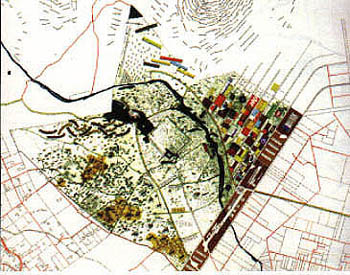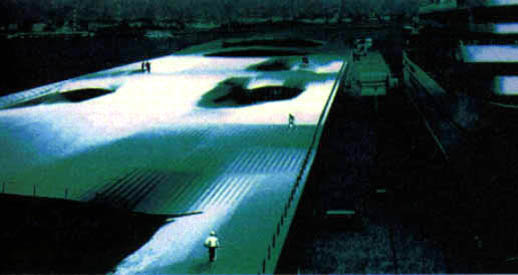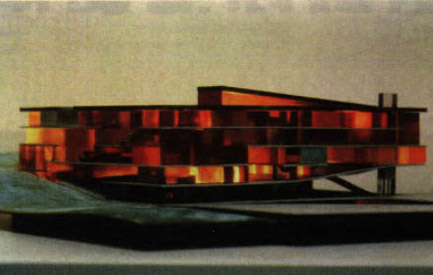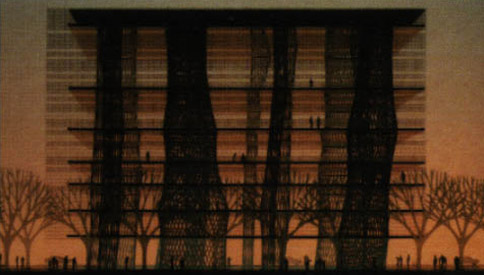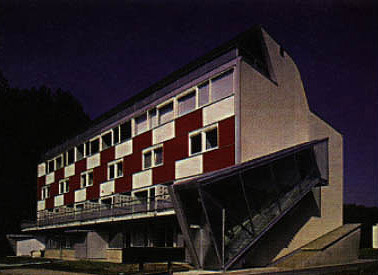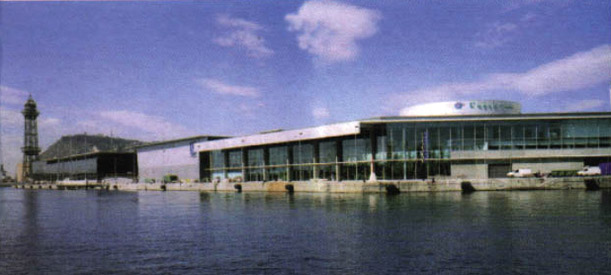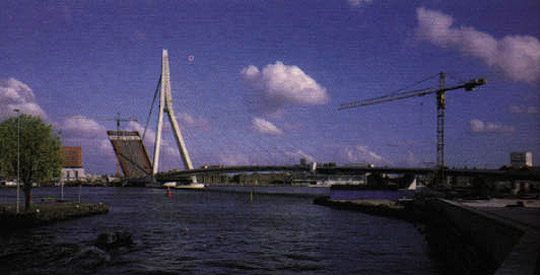| Las
transformaciones urbanas que acontecen en muchas ciudades europeas nos llevan a la
necesidad de redefinir los fenómenos que constituyen este extraordinario paisaje físico
y cultural, conectado con el proyecto urbano y arquitectónico. Para algunos, este nuevo
paisaje se ha asociado al impacto de la tecnología digital, lo que implica una
transformación radical de la vida doméstica y de la noción de hogar a causa del
teletrabajo. Éstas son las tesis mantenidas por Javier Echevarria, que expone la
transición de las metrópolis de principios del siglo XX a las "Teelepolis"
(ciudad global, ciudad de distancias), con nuevas formas de interacción que están
cambiando profundamente los componentes básicos de la vida social: trabajo, producción,
comercio, dinero, escritura, imagen del cuerpo, la noción de territorio, sin olvidar
política, ciencia y cultura [1]. Mientras _Echevarria trata
principalmente de los cambios de los "telehogares" (el espacio público de la
ciudad transformado en lugares de descanso), otros autores como Marc Augé, cosideran que
este cambio público, este nuevo panorama, demanda un estudio casi antropológico [2]. El exceso de modernidad está produciendo los
"pseudo-lugares" (aeropuertos, estaciones de tresn, cadenas hoteleras, parques
de atracciones, cadenas de distribución y redes de telecomunicación). Son lugares donde
el individuo se enfrenta a otra imagen de sí mismo. Los "pseudo-lugares" se
refieren a específicos espacios físicos, pero también a las relaciones que los
"individuos-viajeros" tienen con estos espacios. El proceso de mediación que
establece la unión entre el individuo y el espacio que le rodea es a través de las
palabras, de los textos. Ambos acercamientos, aunque con ligeras diferencias, convergen en
un punto: la primacía del individuo, que es el principal protagonista de este nuevo mundo
(Augé argumenta que si los lugares antropológicos crean un vínculo orgánico social,
los "pseudo-lugares" crean soledad contractual). Así, ¿podemos hablar de una
nueva situación, de las nuevas condiciones de los proyectos arquitectónicos? ¿Cuál
será el uso y el papel de la arquitectura en las transformaciones urbanas actuales, en la
competencia entre las ciudades? ¿Somos capaces de entender las diferencias, o de prever
los cambios que están ocurriendo en la práctica y en el discurso del proyecto urbano y
arquitectónico? Quizás, lo
que se pida hoy en día es la búsqueda de un campo común, que permita un debate
internacional, aparte del reconocimiento de las diferencias. Se busca el campo o campos
que son comunes a muchas formaciones sociales, relacionados con la vida cotidiana y con la
calidad de vida en nuestras ciudades. El reto del proyecto arquitectónico se relaciona
con las cuestiones relativas al tehjido social, dice Peter Eisenman. Puede ser que en esta
afirmación esté latente la sombra del avant garde, la obsesión permanente de las
sociedades post-industriales. Sin embargo, no parece que esto sea un tema principal para
otros, que luchan por enfrentar los problemas del desarrollo incontrolado que actualmente
se lleva a cabo,m con un proceso estético, con todos los efectos brutales de la
tecnología digital, un panorama todavía desconocido.
La ciudad existente, siguiendo las
previsiones de expertos financieros, va acumulando nuevas actividades urbanas, (en el
sector del comercio, la industria de servicio y en el sector del turismo / tiempo libre),
junto a ciertos tipos de habitar en lo que se ha llamado zonas abandonadas o decrépitas [3]. Al mismo tiempo la ampliación de territorios de la ciudad hace
evidente que ya no hay sólo una imagen de cultura sino también una red de
infraestructuras. Obviamente, este acercamiento se basa en una retasación de la
ciudad actual, que diseña estrategias basadas en la transformación y no en su constante
expansión. Ciertamente, este es otro panorama, que requiere otros modos de abordar la
ciudad, otras estrategias de diseño y, obviamente, otros instrumentos de dirigir la
planificación de las poblaciones. Todas estas características tienen en común un
diagnóstico de la crisis del "diseño urbano", muy lejano de las intervenciones
esteticistas y orientadas al objeto que regían los años 80 y principios del los 90.
Primero y principal, la Comunidad
Europea se está transformando en una comunidad de ciudades más que en una comunidad de
naciones. Los expertos dicen que en la reestructuración del mapa europeo, aquellos que
ganan terreno son las grandes regiones urbanas de las metrópolis, y que están superando
sus propias crisis, al gozar de un nuevo centralismo económico, como parís y Milán;
ciudades eje como Bruselas y Frankfurt; poblaciones regionales en fase de desarrollo, como
Lyon; ciudades que son centros de regiones industriales con tecnología flexible, como
Stuttgart o Bolonia; ciudades dedicadas a la ciencia y a la investigación, como Grenoble [4]. En el mismo mapa, van perdiendo terreno las ciudades de producción
masiva, como Turín, las metrópolis que han sufrido una caída en su base productiva,
como Londres; ciudades industriales en proceso de estancamiento, como Bremes, Glasgow,
Liverpool. Un fenómeno global que se puede apreciar es el ascenso del sur alemán,
inglés y francés, en contraste con el "norte" de esos mismo países, que ha
sufrido las consecuencias drásticas de la desindustrialización y de las crisis urbanas.
Por otra parte, mientras se puede notar el éxito de ciudades de tamaño mediano, el
declive de grandes regiones metropolitanas no es un fenómeno general, ya que París,
Milán, Amsterdam, Frankfurt, Lyon o Munich muestran un gran resurgimiento. Lo mismo
ocurre con Berlín, que se ha transformado en una gran área edificada después de la
reunificación alemana.
Sin lugar a duda, en todos estos
casos (regiones en declive, regiones nuevas de desarrollo periférico, ciudades
rehabilitadas), factores locales juegan un papel decisivo en su capacidad de desarrollar
estrategias de cooperación, de movilizar los recursos locales que habían pasado
desapercibidos, de atraer inversiones extranjeras, de integrar su ciudad en una red y
planear su propio desarrollo. En contraste con la política inglesa de neo-liberalismo, se
ha apreciado una recuperación en aquellas ciudades que han elaborado políticas de
planificación, con la colaboración de los sectores públicos y privados, con la
creación de compañías de renovación urbano de capital mixto público y privado, con la
transformación de zonas industriales abandonadas y la creación de nuevas
infraestructuras para las empresas. Lo que debe quedar claro es que en el contexto de |
The
ongoing urban transformation in many European cities are leading to the need for a
re-definition of the phenomena which constitute this extraordinary physical and cultural
landscape, in connection to the urban and the architectural project. For some this new
landscape has been associated with the impact of digital technology, implying a radical
transformation of domestic life and the notion of the home, through telework. These are
the theses of Javier Echeverria, who discusses about the transition from the early 20th
century metropolis to the "Telepolis" (global city, distance city), to this new
form of social interaction which is profoundly changing basic components of social life:
production, work, commerce, money, writing, body image, the notion of territory and
memory, not to mention politics, science and culture [1]. While
Echeverria dwells primarily within the transformed private realm of the
"telehomes" (the public realm of the city itself transformed into a place for
relaxation), other authors, for instance Marc Augé, consider that public realm, this new
landscape, demands an almost anthropological survey [2]. Over-modernity
is producing non-places (airports, train stations, hotel chains, leisure parks,
distribution networks and telecommunication networks); places where the individual is
faced with another image if him or her self. Non-places refer to specific physical spaces,
but also to the relations that individuals-travellers have with these spaces. The process
of mediation which establishes a bond between individuals and their surrounding space of
the non-places passes through words, that is texts. Both approaches, although with sharp
differences, converge on one point: the primacy of the individual, who is the main
protagonist in this new world (Augé argues that if anthropological places created asocial
organic bond, non-places create contractual solitude). So can we speak of a new situation,
of new conditions for the architectural project? What will be the use and role of
architecture within contemporary urban transformation, within the turmoil and competition
among cities? Are capable of understanding differently, or at least touching on in
extremis, or foreseeing, the changes which are taking place within the practice and the
discourse of the architectural and the urban project? Perhaps, what is requested today is the search of a common field, one that
would allow for an international discussion, apart the recognition of differences. Field
or fields which are common to many social formations, in relation to the everyday life and
the quality of living in our cities. The challenge of the architectural project relates to
the questions it raises to the social body than to the offered answers, says Peter
Eisenman. Maybe in this phrase there is somewhere latent the shadow of the avant-garde, a
permanent obsession of the post-industrial societies. It is sure, however, that this is
not a primary issue for the others, which struggle to confront the problems of an
uncontrolled development which is currently undergoing through an aesthetisation process
– with all the abrupt –wild- effects of the unconditioned impact of digital
technology; a still unknown landscape.
The existing city, following the views of
financial experts, is accumulating new urban activities (in the sectors of commerce, the
service industry and the tourism/leisure sector) together with certain types of housing in
areas which have been classed as "derelict" or "abandoned". [3] At the same time the diffusion of the city in the territory makes
evident that it is no longer only an image of culture but a network of infrastructures
also. Obviously, this frame of approach is founded on a re-assessment of the
existing city, with design strategies based on transformation and not on its constant
expansion. This is certainly landscape, which requires other ways of approaching the city,
other design strategies and, obviously enough, other town planning management instruments
– features which all have in common a diagnosis of the crisis in "urban
design", far detached from the object – oriented and aestheticised intervention
during the ‘80s and the early ‘90s.
First and foremost, the
European community is transforming itself into a community of cities rather than a
community of nations. Specialists claim that in the re-working of the European map, those
who are gaining ground are the great urban regions of the metropolises, and that they are
bringing about their own crisis, by calling for a new economic and pitfall centralisation,
such as Paris and Milan; hub towns such as Brussels and Frankfurt; regional metropolises
towns that are undergoing development, such as Lyon; towns that are centres of industrial
regions with flexible technology, such as Stuttgart and Bologna; cities for science and
research, such as Grenoble.
[4] On the
same map, steadily loosing ground are the towns of mass production, such a Turin, the
metropolises that have suffered a serious drop in their productive base, such as London;
proto-industrial regions, in a state of stagnation, such as Brêmes, Glasgow, Liverpool. A
global phenomenon that may be observed is the ascent of the German, French and English
" south", in contrast with the "north" of these same countries, which
has suffered the drastic consequences of de-industrialisation and urban crisis. On the
other hand, whereas the success of medium sized towns may be noted, the decline of great
metropolitan regions is not a general phenomenon, as Paris, Milan, Amsterdam, Frankfurt,
Lyon, Munich all show the same major recovery. The same values for Berlin, which is
transformed into an enormous building site after Germany’s re-unification.
Without a doubt, in all these cases
(regions in decay, new regions of peripheral development, rehabilitated metropolises), a
decisive role is played by local factors and particularly by their capacity to develop
co-operative strategies, to mobilise local resources, which passed unnoticed, to attract
outside investment, to integrate their town into a network and to delineate their own
development. In contrast with the English policy of neo-liberalism, successful recovery
has taken place in towns which have elaborated planning policies, which have
polynuclearity as their goal, particularly through co-operation of public and private
sectors, with the creation of urban renewal companies with joint public/private ownership,
the transformation of abandoned industrial areas and the creation of new service
infrastructures for companies. What must be made clear, is that within the context of the
" foreign policy" of European towns, when a town is to be chosen for investment
(banks, insurance and other companies, real estate investors), it must have adequate
services, a high level of technology, as well as reinforcing its economic infrastructure,
and cultivating its "image", in terms of habitation, environment, social
contacts. This is where the usefulness of urban projects come in, when public architecture
acquires a primordial role, as far as the functioning of networks and the re-qualification
of public space is concerned. This is the real landscape behind all sorts of projects that
are undertaken in many European towns, namely EuroLille, Lyon, Barcelona, Milano, Zurich,
Frankfurt, Stuttgard, Amsterdam, and other. |
|
"inversiones extranjeras" en las poblaciones europeas,
cuando se elige una ciudad para invertir (bancos, compañías de seguros u otras
empresas), debe tener servicios adecuados, un alto nivel de tecnología, así como
reforzar la infraestructura económica y cultivar su imagen en cuanto a población, medio
ambiente y relaciones sociales. Así es como aparecen proyectos de utilidad urbana y
cuando la arquitectura pública adquiere un papel principal. Este es el panorama real que
subyace en todos los proyectos que se llevan a cabo en muchas ciudades europeas, como
Eurolille, Lyon, Barcelona, Milán Zurich, Frankfurt, Stuttgar, Amsterdam y otras.
Está claro que, par
que tenga lugar cualquier proceso de revalorización, por medio de alguna estrategia,
ciertas premisas preestablecidas deben ser consideradas. Para muchos, en esta época
actual de "gobierno débil", las condiciones de retórica, persuasión y
negociación certifican un nuevo status de legitimidad de los proyectos urbanos y
arquitectónicos relacionados con las diversas comunidades que forman las sociedades
urbanas contemporáneas (Gianni Vattimo). De este modo, cuando se lleva a cabo algún
proyecto urbano o arquitectónico de cierta importancia, se necesita lograr un consenso
entre las diversas partes implicadas (organismos públicos, los representantes elegidos
por el pueblo, los grupos empresariales, los vecinos, etc.). Carlo Olmo se ha referido a
la necesidad de establecer algún tipo de "contrato social" en términos de
intervenciones urbanas, "un contrato entre los arquitectos, entre sus
interpretaciones de la ciudad y lo que la ciudad, a través de sus administradores, sus
políticos y sus habitantes tiene que hacer realidad" [5] Para el
historiador italiano, los políticos y administradores son agentes con visiones
colectivas. Y son precisamente esas visiones colectivas lo que el arquitecto ha de tener
en cuenta. De otro modo, si esta relación falla, se encuentra en una posición de
desventaja.
Rem Koolhaas se fijó
en la emergencia de un programa desconocido: "¿Cómo explicar la paradoja de que
URBANISMO como profesión ha desaparecido en el momento que URBANIZACIÓN -después de
décadas de constante aceleración- está camino de lograr el "triunfo" global y
definitivo de la condición URBANA?" [6]. No cabe duda que muchos
proyectos actuales parecen haberse liberado de la garantía ofrecida por la "apertura
en la historia" y estar avanzando en una dirección más conceptual y expresiva. Los
arquitectos parecen buscar más aquellos diseños que se manifiesten en la estructura
amorfa de la ciudad moderna que la verdad metafísica en los centros históricos
cristalizados de esas ciudades. Sin embargo, la "topografía de la arquitectura
contemporánea" aún no está claramente visible. Globalización y tecnología van
paralelos a una nuevo -a menudo arcaico- localismo, mientras están desapareciendo
prácticas más reflexivas. En este sentido, es extremadamente importante notar algunos de
las propuestas emergentes: colonizar la naturaleza, reactuar en las afueras
periféricas, estructurar la complejidad, modernizar el urbanismo de la postguerra,
ordenar los espacios intersticiales, dar formas paisajísticas a los vacíos, que se ponen
de manifiesto en muchos proyectos actuales, y cuestionar su relación con otros modelos,
conceptos y estrategias de intervención arquitectónica, como: la modificación,
el diseño del espacio, la inteligencia del lugar, el objeto urbano,
la forma urbana cartilaginosa.
En estos
acercamientos podemos distinguir nuevas propuestas. sobre todo, están conectadas con el
ambiguo concepto de contexto, con la formalización del proyecto arquitectónico, y con la
definición de los nuevos estilos de vida. Elias Zenghelis, en un texto característico
centrado en el paisaje de la posguerra que hemos heredado y que rechazamos en su totalidad
sin pararnos a examinar, exclama: "si fuésemos más críticos, nos dedicaríamos a
descifrar su inteligencia latente, a corregir sus errores y... a tratarlo como nuestro
contexto innegable" [7]. Esto está a una gran distancia
de la cualidad narrativa del contexto. Si tales conceptos son verdaderos, son claramente
relevantes para la ciudad tradicional y no para la periferia moderna. Esto no significa,
desde luego, que nuestros paisajes actuales -las periferias de las ciudades- no tengan
nada que ver con la narrativa. Su naturaleza narrativa es, en realidad, diferente, es casi
no-narrativa. Esa es la causa por la cual el cine parece estar más cerca de
tocas esos paisajes, ya que los territorios que son explotados, su tiempo y su espacio,
los percibe de modo diferente. Tal actitud orienta el debate y la investigación
arquitectónica de un modo más realista, que parte de la situación dada para poder
responder de un modo crítico.
Cualquiera que sea el
caso, estos fenómenos se han convertido en una gran preocupación para la cultura
arquitectónica. El tea de la XIX Trienal de Milán (27 febrero - 10 mayo 1996) fue
"Igualdad y Diferencia", y, según su director, el arquitecto Pietro Derossi,
dos apartados relacionados con la vida metropolitana surgieron_ la transformación en la
calidad de los espacios públicos y la crisis en los modelos de residencia actuales, que
son incapaces de combinar urbanismo e intimidad [8].
Desde este punto de vista,
deberemos entender y examinar críticamente algunas de las posiciones arquitectónicas en
el discurso contemporáneo. El trabajo de arquitectos como Rem Koolhaas, Jean Nouvel, Zaha
Hadid, Bernad Tschumi, Toyo Ito, Josep Luis Mateo y Herzog/De Meuron, Steven Holl, Enric
Miralles, Carm Pinos, Dominique Perrault,y otros (algunos estudios jóvenes, como Wiel
Arets, kees Christiaanse, Abalos/Herreros, Vicente Guallart, Alessandro Zaera Polo/Foreing
Office, Geipel/Michelin/LAB FAC, Riewe/Riegler, Adriaan Geuze/West 8, Willem Jan
Neutelings, PAUHOF, François Roche, VMX, Bruce Dunning/Peter Versteeg, Ben van Berkel,
Stefano Boeri/Cino Zucchi, Elena y Hrvoje Njiric, Winy Maas, Jacob van Rijs, Nathalie de
Vries/MVRDV, simplemente por nombrar unos pocos), se refieren a una sociedad orientada y
quizás dominada por los medios de masa, y parecen estar más interesados en el cambio de
percepción entre la realidad y el individuo. Sin duda, estamos lejos de los temas de
arquitectura que han caracterizado el debate hasta ahora y nos acercamos a una
redefinición de la práctica de la arquitectura. Quizás sea una falta de sensibilidad
entre generaciones; quizás sea una condición cultural más general en la que el proyecto
urbano y arquitectónico se convierten en provisiones de ideas y propuestas concretas para
los retos que el desarrollo actual nos ofrece. |
It is clear that,
for any process of re-valorisation to take place, through an operational strategy, certain
pre-established roles must be laid down and reconsidered. For many, in the present era of
"weak government", the conditions of rhetoric, persuasion and negotiation attest
to a new status of legitimacy of the architectural and the urban project which relate to
the heterogeneous fabric, and to the various communities which make up contemporary urban
societies (Gianni Vattimo). Therefore, when any significant architectural or urban project
is to be undertaken, the required condition is to succeed in establishing a cultural
consensus between the various parts which contribute to its implementation ( public
bodies, town’s elected representatives, lobby groups, community groups, etc.). Carlo
Olmo has referred to the necessity to establish a kind of a new "social
contract" in terms of significant urban interventions, " a contract between the
architects, between their interpretations of the city and what the city, through its
administrators, its politicians and its residents has to make a reality". [5] For the Italian historian, politicians and administrators are agents
of collective visions, and it is precisely these collective visions which the architect
has to take into account; otherwise, if he lacks this relationship, he finds himself is a
position of disadvantage. Rem Koolhaas focused on the
impasse to confront this undergoing development, the emergence of an unknown landscape:
"How to explain the paradox that URBANISM as a profession, has disappeared at the
moment when URBANIZATION everywhere – after decades of constant acceleration –
is on its way to establish a definitive, global "triumph" of the URBAN
condition?" [6] There can be no doubt that many contemporary
projects seem to have liberated themselves from the guarantee offered by the "opening
on history" and to be advancing in a more conceptual and expressive direction.
Architects appear to be in search more of the possible ways in which design gestures could
manifest themselves in the amorphous
structure of the modern city than of some metaphysical
truth in the crystallised historical centres of those cities. However, the
"topography of contemporary architecture" is not clearly visible yet.
Globalisation and "fascinism" with technology go parallel to a new – often
"archaic" – localism, while more "reflexive" practices are
disappearing. In this sense, it is extremely important to note some of the emerging
approaches, such as: colonising nature, reacting to peripheral suburbia,
structuring complexity, modernising the post-War urbanism, ordering interstitial spaces,
contextualising memory, landscaping the void, which are manifested in many contemporary
projects, and to question their relationship with other models, concepts and strategies of
architectural intervention, such as: the modification, the design of the void, the
intelligence of the site, the urban object, the cartilaginous urban form.
Within these approaches we can distinguish new themes:
above all, these are connected with the ambiguous concept of context, with formalisation
of the architectural project, and with the definition of new life-styles. Elias Zenghelis
in a highly characteristic text focused on the post-War landscape that we have inherited
and that we are rejecting wholesale without bothering to examine the extent to which it
corresponds to our reality, claims that "if we were more critical, we would endeavour
to decipher its latent intelligence, correct its mistakes and... treat it as our undeniable
context". [7] This is a long way from concepts of the narrative
quality of the context. If such concepts hold true, they are clearly relevant to the
traditional city and not to the modern periphery. This is not to say, of course, that our
contemporary landscapes – the peripheries of the city – have nothing to do with
the narrative; their narrative nature is in fact different, it is almost a non-narrative.
That is why the cinema seems to come to touching those landscapes, since the territories
being explored, their time and the space, are perceived by it in a different way. Such an
attitude, it does orientate the debate and the architectural research in a more realistic
direction, one which departs from the given existing situation in order to be able to
respond critically to it.
Whatever the case might be, these phenomena have become a
major concern within the architectural culture. The theme of the XIX Trienale of Milan (27
February – 10 May 1996), was "Identity and Difference", and –
according to its scientific director architect Pietro Derossi – suggested two
subjects as preferred field of inquiry in order to observe the condition of
metropolitan living: the transformation in the quality of public spaces that is under way
and the crisis in modern residential models, which are incapable of combining urbanism and
intimacy [8].
In the first field, within the city, subject to continual
processes of modification, there is also room for activities that occupy interstitial
spaces or utilise the flexibility of certain places to propose improper uses for them.
These are improvised occupations based on temporary structures and represent a modern
version of the ancient lurk of nomadism (unauthorised housing, flea markets,
improvised meeting centres, spaces for games, experimental workshops, etc.). On the other
side, in complete contrast to the transient nature of these interstitial improvisations is
provided by the recent proliferation of large containers in the outskirts of the city,
which bring together groups of functions of a public character (in majority commercial,
but also leisure, convention sports, snd catering facilities). In the second, the
expansion of the contemporary city is taking place in suburban areas, with the emergence
of large residential districts with a medium building density. This involves both the
proliferation of single-family residences and the development of large public-housing
projects. In this decentralised and monofunctional metropolis, what role is played by the
private spaces in which the inhabitant seeks and defends moments of intimacy? Barely has
the need for quality of the interior been considered an important element in the design of
the overall organisation of spaces in a housing complex. On the other hand the quest for
privacy has to face up to the realisation that it can only exist within a network of
relationships, a network that gives intimacy the status of a node in a social dialogue.
The above mentioned topics indicate that the Triennale took
over some of the already existing issuer which were latent for some time now within the
network of the architectural culture in Europe related to the undergoing urban
transformations and set up on a background which goes from the philosophical argumentation
on post-modernity (Lyotard), to the "weak thought", that is, under the
constellation of the end of the big narratives, and the crisis of rationality, and the
need to legitimise the architectural project in relation to the mamy local voices and
different communities whic constitute contemnporary society (Vattimo). |
|
En el
primer caso, en la ciudad, sujeta a continuos procesos de modificación, hay también
sitio para actividades que ocupan espacios intersticiales o aprovechan la flexibilidad de
ciertos lugares para proponer usos que no le son propio. Estas son ocupaciones
improvisadas basadas en estructuras temporales y representan una versión moderna del
antiguo nomadismo (ocupación ilegal de casas, mercados callejeros, centros de reunión
improvisados, espacios para juegos, talleres experimentales, etc.,). Por otra parte, en
contraste con la naturaleza transitoria de estas improvisaciones, se halla la reciente
proliferación de grandes centros en las afueras de la ciudad, con funciones de carácter
público, (en su mayoría comercial, pero también de ocio, deporte y tiempo libre). En el
segundo caso, la expansión de la ciudad actual se está produciendo en las zonas
suburbanas, con la aparición de grandes distritos residenciales con una densidad de
edificios media. Esto implica la proliferación de casas unifamiliares y el desarrollo de
grandes proyectos de vivienda pública. En esta metrópolis descentralizada y
monofuncional, ¿qué papel juegan los espacios privados en los que los habitantes buscan
y defienden sus momentos de intimidad? La calidad de los interiores apenas se ha
considerado en el diseño de organización de los complejos de viviendas. Por otra parte
la búsqueda de la intimidad tiene que enfrentarse al hecho de que sólo puede existir
dentro de una red de relaciones, una red que dé a la intimidad el status de
centro en un diálogo social. Los temas arriba mencionados indican que la Trienal abarcó algunos de los
asuntos que estaban latentes durante algún tiempo en el marco de la cultura
arquitectónica en Europa. Todos ellos relacionados con las transformaciones urbanas que
se llevan a cabo y basados en la argumentación filosófica de la post-modernidad
(Lyotard), y en el "pensamiento débil", es decir, en la constelación del fin
de las grandes narrativas, la crisis de la racionalidad y la necesidad de legitimar el
proyecto arquitectónico en relación con los varios implicados y las diferentes
comunidades que constituyen la sociedad contemporánea (Vattimo).
Después de la Trienal, le llegó
el turno a la exposición central y al debate del XIX Congreso de la UIA de Barcelona (2-7
julio 1996). Allí se propuso, según el profesor Ignasi de Solà-Morales, no un sistema
exhaustivo de análisis de las nuevas relaciones entre la arquitectura y la ciudad
contemporánea, sino simplemente cinco plataformas: cambios, corrientes, residencias,
locales y terreno indefinido, como campos de explotación de esta nueva situación, que se
escapa de lo establecido acerca de la figura profesional del arquitecto y de los modos de
describir e intervenir en la ciudad [9]. Los retos ofrecidos por estas
categorías culturales, como base para la compresión de las nuevas relaciones entre la
arquitectura y las grandes metrópolis de hoy, ponen en evidencia: a) lo inadecuado del
modelo evolutivo-organicista y del racionalista para tratar los fenómenos y los procesos
de la repentina mutación de la ciudad; b) la comprensión del movimiento como
yuxtaposición, interconexión y distribución de múltiples corrientes; c) la presencia
de áreas de experimentación e innovación relacionadas con el problema de los espacios
residenciales (viviendas para grupos marginales o atípicos, lugares privilegiados de las
casas unifamiliares, la construcción alternativa del Tercer Mundo, y la definición de
habitar según los componentes); d) la emergencia de locales como centros donde se produce
el intercambio, la venta, la distribución de productos que suponen el consumo de nuestra
sociedad altamente ritualizada: (museos, estadios, centros comerciales, parques
temáticos, centros turísticos) y e) la presencia en la ciudad contemporánea de
territorios vacíos, improductivos y obsoletos, pero también imprecisos y sin definir.
Sin embargo, deberíamos considerar que la "metrópolis contemporánea ya no es un
lugar o una forma única, ni un solo estado evolutivo ni un movimiento aislado, sino la
acumulación de múltiples estados, de acciones y experiencias simultáneas" (Manuel
Gausa).
Finalmente, le llegó el turno a la Sexta Exhibición Internacional de Arquitectura de la
Bienal de Venecia (septiembre-noviembre 1996), de debatir sobre el arquitecto como
individuo que se enfrenta a un mundo cambiante dominado por la tecnología y los medios de
comunicación. Según su Director Hans Hollein: "Hoy hay otras visiones de la ciudad,
nuevos fenómenos que expanden la idea del centro de la ciudad, no ya como plaza del
mercado-iglesia-ayuntamiento. Los complejos sistemas de comunicación y las nuevas
tecnologías, junto a los medios de transporte y los avanzados métodos de construcción
están determinando la planificación, el desarrollo y la realización de nuestro medio
ambiente... Hoy los arquitectos son sismógrafos culturales de la situación que los
envuelve y sus trabajos lo reflejan, proyectándolos hacia el futuro. En su trabajo
individual específico, no tratan solamente de resolver problemas, sino que hacen
manifestaciones sobre el potencial de la arquitectura, resolviendo nuevas necesidades,
inventando conceptos innovadores para una vida que cambia, entrando en nuevos territorios,
percibiendo situaciones todavía desconocidas" [10].
Sin embargo, muchas cuestiones
permanecen sin respuesta. ¿Quiénes serán los nuevos habitantes de esa "nueva
periferia", en la frontera del centro histórico, en la naturaleza que la rodea,
cerca de artefactos hechos por el hombre o por la naturaleza? Sabemos que la población de
las ciudades de Europa no es una entidad social, económica y cultural única. En
realidad, en términos de composición social y de población la situación es
extremadamente fluida, a menudo explosiva. Por esta falta de definición del ocupante (el
mayor problema al que se enfrenta la vivienda), muchos arquitectos actuales parecen
reflejar el nuevo ambiente de primitivismo social en el paisaje contemporáneo. En este
contexto, si la década pasada se caracterizaba por la arquitectura de "igualdad y
diferencia" y la arquitectura de "la lógica del límite", ambas próximas
a los discursos artísticos dominantes, principalmente arte povera y minimalismo [11], podemos presenciar en los próximos años una separación del arte
después de la explosión de las fronteras entre arte y arquitectura y una búsqueda de
temas antropológicos. |
After the
Triennale it was the turn of the central exposition and debate of the XIX UIA Barcelona
Congres (2-7 July 1996) to propose -according to the curator Ignasi de Solà-Morales- not
an exhaustive system of analysis of the new relationsbetween architecture and contemporary
city, but merely five platforms (mutations, flows, habitations, containers, and terrain
vague), as fields of exploration of this new situation, which escapes the established
status of the professiional figure of the architect but also the traditional ways of
describing and intervening in the city [9]. The challenges
offered by these cultural categories, as a basis for understanding the new relationships
between architecture and the great metropolis of today, put in evidence: a) the inadequacy
of the organicist-evolutionary model as well as of the causal logic of the rationalist
model to deal with the phenomena and the processes of sudden mutation of the city; b) the
understanding of motion as juxtaposition, interconnection and distribution of a
multiplicity of flows; c) the presence of areas of experimentation and innovation in
relation of the problem of residential spaces (houses for atypical and marginal groups,
the privileged site of the detached family residence, the alternative Thirld World
construction, and of the definition of the dwelling on the bases of components); d) the
emergence of containers as places in which are produced the exchange, the expense, the
distribuion of gifts that constitute the multiple consumption of our highy ritualizad
societies (museums, stadiums, shopping malls, theme parks, tourist centres); and c) the
presence of coid, unproductive, obsolete but also imprecise, undefined, without ixed
limits territories in the contemporary city. However, we should consider that "the
contemporary 'metapolis' is no longer a unique place or a unique form, but neither is it a
single evolutionary state nor a single movement, rather it is the accumulation of multiple
states, actions and simultaneous experiences" (Manuel Gausa). Finally, it was the turn of the 6th International Architecture Exhibition of
the Venice Biennale (September-November 1996) to refocus on the architect-individual
facing a changing world pervased by communication and media, according to its Director
Hans Hollein: "Today there are hanging visions of the city, nes phenomena expand the
idea of the city center -no longer just market square-church-town hall. Complex
comunications systems and new technologies, hanging means of transport and advanced
methods of construction are determing the planning, development and realisation of our
environment... Architects today are cultural seismographs of an evolving situation they
register and their work reflects this very situation -projecting it into hte future. In
their specific individual work on individual tasks they deal not primarly with solving
problems, but they are making statements about the potential of architecture- ansewring
new needs, inventing innovative concepts for a changing life, entering new territories,
sensing yet unknown situations" [10].
However, many questions remain still open. Who will be the
ingabitants of this "new periphery", on the boundary of the historic city, in
the surrounding nature, next to natural features or manmade artifacts? We know that the
population of the cities of Europe is not a single social, economic or cultural entity; in
fact, in terms of population and social composition the situation is extremely fluid,
often explosive. This relative lack of definition of the user (the greatest problem facing
housing) is what seems to be leading many contemporary architects to touch the new
ambience of social primitivism in this contemporary landscape. In this context, if the
past decade was characterised by the architecture of "identity and difference"
and the architecture of "the logic of the limit", both in proximity to the
dominant artistic discourse, namely arte povera and minimalism [11],
we may witness in the coming years a detachment from art after the explosion of the
boundaries between art and architecture and a search towards anthropological issues.
In this framework we will have to understand and critically
examine some of the most challenging architectural positions in contemporary architectural
discourse, the work of architects like Rem Koolhaas, Jean Nouvel, Zaha Hadid, Bernard
Tschumi, Toyo Ito, Josep Luis Mateo and Herzog/De Meuron, Steven Holl, Enric Miralles,
Carme Pinos, Diminique Perrault, and others of course (amongst which some younger offices,
like those of Wiel Arets, Keees Christiaanse, Abalos/Herreros, Vicente Guallart,
Alessandro Zaera Polo/Foreign Office, Geipel/Michelin/LAB FAC, Riewe/Riegler, Adriaan
Geuze/West 8, Willem Jan Neutelings PAUHOF, François Roche, VMX, Bruce Dunning/Peter
Versteeg, Ben van Berkel, Stefano Boeri/Cino Zucchi, Elena and Hrvoje Njiric, Winy Maas,
Jacob van Rijs, Nathalie de Vries/MVRDV, just to mention a few), who refer to a mass-media
oriented, and perhaps dominated, society and seem to be more interested in the change of
perception between the reality produced and the user. No doubt, we are far away from the
architectural themes which characterised the debate until now and closer to a
re-definition of the architectural practice. Perhaps, it is a matter of a different
sensibility between generations; perhaps, it is a more general cultural condition in which
the architectural and urban project could become reservoirs of ideas and concrete
proposals for the challenges offered by the undergoing development.
|

